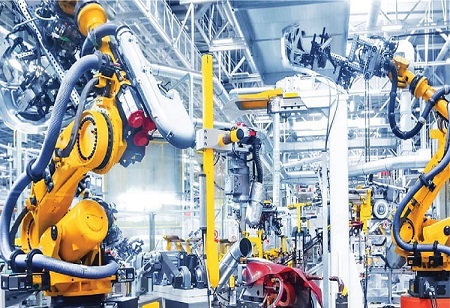The manufacturing sector has particularly led the stock market in 2022, leaving other industries behind. These sectors command the centre stage in the manufacturing include FMCG, automotive, pharmaceuticals, metals, cement, and agrochemicals, according to a report by Business Standard. The manufacturing companies' stock from these sectors have performed well and this is why they have been leading with a bigger weight in the benchmark index. In Nifty50 index,
manufacturing companies from the six sectors mentioned above constituted of 25.43%, which was a positive 0.88% from the percentage at the end of December 2021.
Now that we have an overview of which sectors performed better, let us look at the reasons why they did well and find out what manufacturers are doing to outpace the market. In this article we provide an overview of 4 sectors of these sectors.
Metal Fabrication
Metal fabrication industry has undergone a sea change over the past year. Fabricators have embraced automation to boost their cutting throughput like never before. Fueling the growth of this sector is the orientation of global manufacturing companies towards diversifying their production by establishing low-cost plants in India. The public infrastructure spending by Indian government has also given a fillip to the growth of metal industry.
Going forward, the government intends to introduce the use of 'green steel' in government projects. “In order to promote the production of green steel in India, the government is considering mandating the use of 'green steel' in government projects and is also in discussion with steel manufacturing companies to dedicate a portion of their production to manufacture green steel,” said Jyotiraditya M. Scindia, Union Minister of Steel and Civil Aviation, at an event recently.
Agrochemicals
As more and more farmers realize the increasing need to supply essential nutrients to crops for maximum yield, the demand for fertilizers and crop protections products is growing incessantly.
A sharp increase has been seen in 2022 in the penetration of crop protection chemicals. Herbicides and fungicides are being used more to counter rodent and pest attacks faced by crops.
To accelerate research and innovation in this field, government and industry have joined hands. There is an increased focus on developing new generation molecules and isomers. Molecules of organophosphorus, carbon disulphide and pyrethroid chemistries manufactured by Indian agrochemical companies have made their mark in global market through their quality and cost-effectiveness. There is also an orientation towards green chemistry products to reduce the dependence on non-renewable resources.
Automotive
Automotive market in India is expected to grow at a CAGR of more than 11 percent till 2027. Comprising approximately 40 percent of the manufacturing GDP, the sector has hit the ground running to embrace the EV revolution. CEEW Centre for Energy Finance sees an opportunity of more than 200 USD for electric vehicles by 2030. The sector is attracting heavy investment not just in vehicle manufacturing but also in charging infrastructure. Year 2022 saw the passenger vehicle exports surging to record levels in the past eight years, amounting 576,000 units, significantly up from 440,000 in the preceding fiscal year. At the same time, two-wheeler export reached a mark of 4.4 million units, exhibiting highest ever increase in exports.
While the growth continues, there are challenges in the way which are being solved through technological innovation. As the demand for chips rises in automotive industry, manufacturers are gearing up to counter the chip shortage. For instance, Hyundai is leveraging software-based alternatives for improving car functions and enhancing user experience to reduce its dependence on microchips.
Pharmaceuticals
Growing at a CAGR of more than 10 percent, pharmaceutical industry in India has set a new benchmark for the global one. In particular, Active Pharmaceutical Ingredients (API) pharma companies in India are being forecasted to traverse a growth curve of 16 percent. Fueling this growth is the focus on R&D and innovation to develop new drugs to meet the emerging medical requirements in the fields of cardiovascular disease, oncology, neuroscience, and diabetes.
In addition to drug development, pharma companies in India are adopting new technologies to enhance their engagement with patients. By leveraging artificial intelligence and automation, they are garnering actionable insights into patient journey, redefining the process from diagnosis to disease management. This is in turn improving not only dug development but enhancing patient outcomes as well.
Driven by technology advancements and policy initiatives, the manufacturing industry is on its way to be a frontrunner globally. Adopting Industry 4.0 and reaping the benefits of National Manufacturing Policy, manufacturers are exhibiting unprecedented acumen for innovation and taking giant strides towards increasing the contribution of manufacturing in GDP to 25 percent by 2025.
